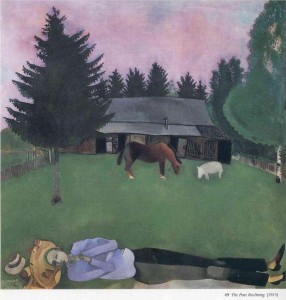William Shakespeare. Sonnet 27
Weary with toil, I haste me to my bed,
The dear repose for limbs with travel tired;
But then begins a journey in my head,
To work my mind, when body’s work’s expired:For then my thoughts, from far where I abide,
Intend a zealous pilgrimage to thee,
And keep my drooping eyelids open wide,
Looking on darkness which the blind do seeSave that my soul’s imaginary sight
Presents thy shadow to my sightless view,
Which, like a jewel hung in ghastly night,
Makes black night beauteous and her old face new.Lo! thus, by day my limbs, by night my mind,
For thee and for myself no quiet find.
Sam Alexander reading this sonnet
This is about as close to a straightforward illustration as the sonnet series has gotten so far; probably too straightforward – as of now, I am not quite sure whether this painting is going to survive in this form, or be transformed into something more abstract. For now, though, this is the twenty seventh sonnet painting.
It’s very straightforwardness owes much, I believe, to the fact that my sonnets series has significantly intersected with my Chagall studies project (not a coincidence, either: one of the things I wanted to learn from Chagall is his child-like directness and playful seriousness).
That said, there are two Chagall paintings which are related to this sonnet painting more closely (albeit loosely). One is “The poet reclining” (1915, above), which emboldened me to try for a composition with the main character confined to the bottom of the painting (although my poet is, of course, much less serene. The other is “Self-portrait with muse” (1918, left), which according to Chagall’s autobiography, “My life”, represents an actual dream-like vision of his beloved, Bella, as a white angel. The motive is the same as in Shakespeare’s sonnet: it’s not a long way from a white angel to a jewel hung in ghastly night.


